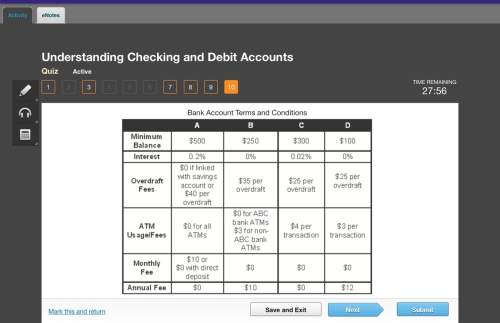
Business, 28.05.2020 02:09, youtubeviewer109
On December 31, the following data were accumulated for preparing the adjusting entries for Bellingham Realty: • The supplies account balance on December 31 is $5,640. The supplies on hand on December 31 are $1,445. • The unearned rent account balance on December 31 is $5,400 representing the receipt of an advance payment on December 1 of four months’ rent from tenants. • Wages accrued but not paid at December 31 are $2,125. • Fees earned but unbilled at December 31 are $18,590. • Depreciation of office equipment is $4,785. Required: 1. Journalize the adjusting entries required at December 31. Refer to the Chart of Accounts for exact wording of account titles. 2. What is the difference between adjusting entries and correcting entries?

Answers: 2
Other questions on the subject: Business

Business, 21.06.2019 21:00, shelbycade230
Following is a list of various costs incurred in producing replacement automobile parts. with respect to the production and sale of these auto parts, classify each cost as either variable costs, fixed costs, or mixed costs. 1. oil used in manufacturing equipment 2. plastic 3. property taxes, $165,000 per year on factory building and equipment 4. salary of plant manager 5. cost of labor for hourly workers 6. packaging 7. factory cleaning costs, $6,000 per month 8. metal 9. rent on warehouse, $10,000 per month plus $25 per square foot of storage used 10. property insurance premiums, $3,600 per month plus $0.01 for each dollar of property over $1,200,000 11. straight-line depreciation on the production equipment 12. hourly wages of machine operators 13. electricity costs, $0.20 per kilowatt-hour 14. computer chip (purchased from a vendor) 15. pension cost, $1.00 per employee hour on the job
Answers: 3

Business, 22.06.2019 11:40, lmiranda5034
Zachary company produces commercial gardening equipment. since production is highly automated, the company allocates its overhead costs to product lines using activity-based costing. the costs and cost drivers associated with the four overhead activity cost pools follow: activities unit level batch level product level facility level cost $ 64,800 $ 27,730 $ 15,000 $ 154,000 cost driver 2,400 labor hrs. 47 setups percentage of use 11,000 units production of 780 sets of cutting shears, one of the company’s 20 products, took 240 labor hours and 7 setups and consumed 15 percent of the product-sustaining activities. required: (a) had the company used labor hours as a company wide allocation base, how much overhead would it have allocated to the cutting shears? (b) how much overhead is allocated to the cutting shears using activity-based costing? (c) compute the overhead cost per unit for cutting shears first using activity-based costing and then using direct labor hours for allocation if 780 units are produced. if direct product costs are $150 and the product is priced at 30 percent above cost for what price would the product sell under each allocation system? (d) assuming that activity-based costing provides a more accurate estimate of cost, indicate whether the cutting shears would be over- or underpriced if direct labor hours are used as an allocation base. explain how over-or undercosting can affect vaulker's profitability. (e) comment on the validity of using the allocated facility-level cost in the pricing decision. should other costs be considered in a cost- plus pricing decision? if so, which ones? what costs would you include if you were trying to decide whether to accept a special order?
Answers: 1

Business, 22.06.2019 12:10, montgomerykarloxc24x
The cost of the beginning work in process inventory was comprised of $3,000 of direct materials, $10,000 of direct labor, and $10,000 of factory overhead. costs incurred during the period were comprised of $15,000 of direct materials costs, and $100,000 of conversion costs. the equivalent units of production (eup) for the period were 9,000 for direct materials and 6,000 for conversion. the costs per eup were:
Answers: 3

Business, 22.06.2019 12:40, daphnewibranowsky
Kumar consulting operates several stock investment portfolios that are used by firms for investment of pension plan assets. last year, one portfolio had a realized return of 12.6 percent and a beta coefficient of 1.15. the average t-bond rate was 7 percent and the realized rate of return on the s& p 500 was 12 percent. what was the portfolio's alpha?
Answers: 1
Do you know the correct answer?
On December 31, the following data were accumulated for preparing the adjusting entries for Bellingh...
Questions in other subjects:






Mathematics, 05.11.2020 01:20

Mathematics, 05.11.2020 01:20


Mathematics, 05.11.2020 01:20







